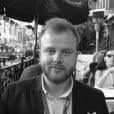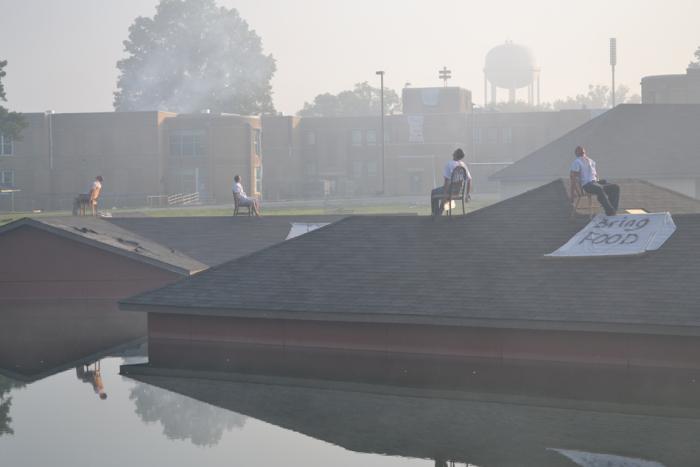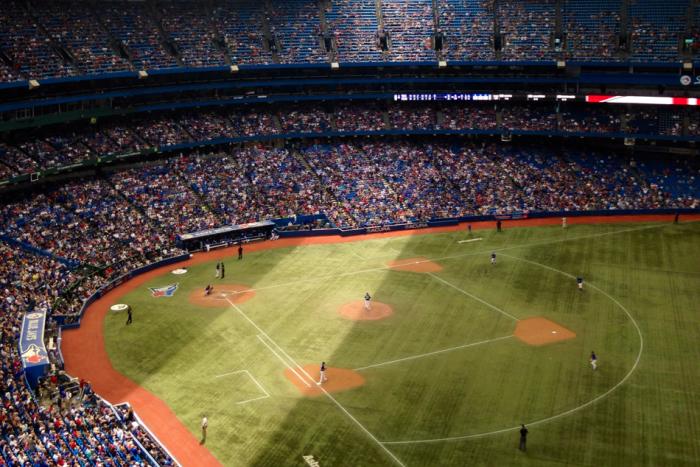Nobody shoots movies as well as Roger Deakins. He is without question our greatest cinematographer: an exemplar without comparison. A twelve-time Academy Award nominee, longtime partner of the Coen brothers, and indispensable collaborator of, among others, David Mamet, Sam Mendes, Martin Scorsese, and of late Denis Villeneuve, he is incapable of capturing a lacklustre image. His work is probably stamped in your subconscious whether you realize it or not: think of Bond’s luminous entrance by boat in Macau in Skyfall, of Tim Robbins standing in the downpour in Shawshank Redemption, of Steve Buscemi digging through the snow on the side of the road in Fargo—all Deakins. He makes a strong case for us to consider the director of photography as auteur. His presence alone is reason enough to see a film.
The latest Deakins glory is Sicario, another collaboration with Canadian director Denis Villeneuve that concerns the efforts of a mysterious American task force to take the war on drugs into Mexico. It opens in wide theatrical release this week—to almost universally rapturous praise, even—after enjoying its North American premiere last month at the Toronto International Film Festival. It was there that we had the privilege to sit down with the maestro to talk about his methods and affinities—though I couldn’t resist leading with a more pressing question.
*
Calum Marsh: Why are you so much better at your job than everybody else?
Roger Deakins: [Laughs] Well, what is best? Define “best.” It’s rather like that Zen and the Art of Motorcycle Maintenance thing: define “quality.” You can’t. There’s no such thing as best. What’s the best shot? What’s the best lighting? There’s an infinite number of ways of doing things—and some just connect with an audience and some don’t. Some have a particular kind of individual way of expressing what’s in the script and some don’t. But what’s best? I don’t know.
Okay: let’s say best in the way that Caravaggio is the best.
See, I don’t think Caravaggio was the best! I’m sorry, but not my favorite. Edvard Munch, I would say, is the best. Not Caravaggio. It’s not just about chiaroscuro lighting. It’s not about that.
Leaving best aside, then—
Good.
What do you think when you see other films? Most films aren’t beautiful.
It depends on the film. I watch things sometimes and I think, “Oh my god, I can’t do that.” They make me feel completely useless. But then some films I watch and think: why do they bother? But that’s natural, isn’t it?
Is it that some directors simply don’t care?
I think it has a bit to do with the way filmmakers approach filmmaking these days. There’s a certain body of filmmakers who just stick up multiple cameras on zoom lenses. There’s a certain body of filmmakers for whom it’s about the coverage, you know. For me it doesn’t matter: I have a different sensibility, I suppose. One thing about working with the Coen brothers for a long time is that they don’t shoot stuff they don’t want. It’s very precise. Everything is storyboarded and everything is thought out. Everything is really considered. You get there on the day and you can do anything as well, but it’s all very, very considered in pre-production and on the day. The few times I’ve worked in situations where it’s not been like that, I think the work shows.
I spoke to Denis Villeneuve a few years ago, when Prisoners was at the festival. And I spoke with him about working with you. He gave me the impression that with you he’s quite ... deferential.
No! We bandy things around. He’s very sweet, but it really is a collaboration. We go back and forth. With anybody I’ll say my opinion: I don’t think I’m there just to keep mum and push a button. It’s always a discussion, you know. I suppose I do have a thing about ostentatious camerawork or any extraneous move. If the camera moves it’s got to be for a reason. And I will say: watch a Bresson! He doesn’t move the camera because he can’t find a reason to do it, so why should we? You know what I mean? More and more I tend towards that kind of … it’s not just simplicity, but it’s focusing on what’s important in the film without any extraneous nonsense.
A lean style, then—no fat.
Yeah, yeah.
On the other hand, there do seem to be shots in Sicario that are … well, not showy exactly, but let’s say stylistically pronounced. At one point, for example, there’s a bird’s-eye-view shot of an airplane taking off. I’ve never seen anything like that before.
That was Denis. We talked about that, but Denis was with the helicopter cameraman while I was doing a pre-light that weekend. [Laughs] But we talked about that. The shadow is CG.
I’d wondered about that. I was thinking, too, about the one everyone loves: the static shot of soldiers receding into the distance in front of a blazing orange sunset. It’s held for an unusually long time.
People say that the film has got a tension to it. When you think about that shot—I mean, because he holds it, and the guys disappear, and then he still holds it with nobody in the frame—it builds a tension that normally would be done, or a filmmaker would attempt to do, with a lot of cuts. But this is building tension just by holding a shot, and that particular shot because it’s the idea of the darkness and where we’re going.
There’s a great storm shot, too—a long shot when Benicio Del Toro on the Mexican highway, and there are these storm clouds rolling in from the distance.
Right, yes, with the cop car.
Happenstance?
The storm was really there. We were told to wrap because this severe thunderstorm was coming in. Basically Denis and I stayed there with a camera as people were wrapping up and just shot that.
How do you reconcile these sorts of happy accidents with the precision and planning you were saying you value so much?
I mean, when we were planning and talking about the film in general, we imagined it being obviously quite colorful, especially as a contrast to Prisoners, for instance. We wanted to use the blue skies, but we thought it would be these very empty skies against harsh landscapes. Of course when we were actually shooting it we were in this active monsoonal season in New Mexico, so we got these incredible skyscapes. We just said, “Well, we’ve just got to go with it,” and I think it adds something very interesting to the overall look of the film. But it wasn’t expected. We didn’t have that at the beginning, when we shot the raid on the house: that’s still quite bald and I think that’s good. But gradually you get these intense, interesting skies. It’s there so you use it.
I suppose you could just CGI in whatever sky you’d like now.
That’s the scary thing. And people know it. You shoot something real and people say, “Well, that’s not real anyway.” A few years ago I did a movie and someone said it was all CG, even though it was all done in-camera. People can’t judge anymore.
I find myself doubting, too.
And, well, it does go on, the reverse. When we did Unbroken, people said, “Oh, how did you get all that?” And I said, “Well we didn’t have a plane that flew, we did it all on stage and it’s all blue screen and composites.” So it’s good sometimes.
There’s a great shot right at the beginning of dust particles suspended before a window in a thin shaft of light.
Yeah. That whole opening was a bit of a struggle, just trying to figure out how to get that. We wanted something that took the kind of curse off the SWAT team coming, but we wanted to get a sense of foreboding or something.
Not computer-generated dust.
Real dust! We put dust in there to make it work. That was something that Denis thought: there was the shaft of light coming through the window and he suggested we perhaps see the merest shadow going past.
And the dust returns later.
Yes, when Emily is lying in bed after the whole thing and she’s watching the dust particles.
One more shot: the thermal and night vision sequence. Was that a post-production effect?
No! We used a night vision system and a thermal imaging camera—we got a company that makes this scientific camera for basically specialist situations. That whole sequence was hard, because how do you show this at night when they can’t see anything? That’s why they’re wearing these enhancing systems, because it’s so dark. It was all going to be night vision, but Denis wanted to know if there was something else we could use. That’s when we discovered we could use thermal vision—and then combine them, so you know that the thermal was what Alejandro was seeing and the rest was the team. We decided we should do the whole scene that way because it’s the only way it makes sense. Unless you had just a shot of black and said that was the objective view of what was going on.
There is of course the classic “movie dark,” where it’s just sort of blue.
Yeah, exactly. But it doesn’t make sense. If they could see and you could see then they wouldn’t be wearing these silly things. There’s one shot, where the guy comes in and draws his knife and is walking into the tunnel, and it’s an objective thing, really dark.
And astonishingly beautiful.
And we thought, well, that’s the only shot that’s going to show what it’s like if you’re not wearing one of these enhancing systems.
The whole thing reminded me of a video game, clichéd as that sounds.
In the sense that all war now is like a video game, yeah. And though you say it’s like a video game, it does add to the kind of confusion that they would be feeling. Then you have these aerial shots—which are actually kind of CG, because the aerial shots are just a negative of a daylight shot that looks like that—but that gives you the geography of what’s going on.






